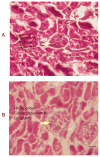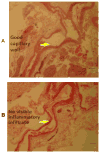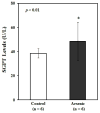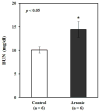Arsenic-induced Histological Alterations in Various Organs of Mice
- PMID: 26740907
- PMCID: PMC4698904
- DOI: 10.4172/2157-7099.1000323
Arsenic-induced Histological Alterations in Various Organs of Mice
Abstract
Deposition of arsenic in mice through groundwater is well documented but little is known about the histological changes of organs by the metalloid. Present study was designed to evaluate arsenic-induced histological alterations in kidney, liver, thoracic artery and brain of mice which are not well documented yet. Swiss albino male mice were divided into 2 groups and treated as follows: Group 1: control, 2: arsenic (sodium arsenite at 10 mg/kg b.w. orally for 8 wks). Group 2 showed marked degenerative changes in kidney, liver, thoracic artery, and brain whereas Group 1 did not reveal any abnormalities on histopathology. We therefore concluded that arsenic induces histological alterations in the tested organs.
Keywords: Arsenic; Histopathology; Mice organs.
Figures






Similar articles
-
Protective effects of phyllanthus emblica leaf extract on sodium arsenite-mediated adverse effects in mice.Nagoya J Med Sci. 2015 Feb;77(1-2):145-53. Nagoya J Med Sci. 2015. PMID: 25797979 Free PMC article.
-
Protective effect of Mentha piperita against arsenic-induced toxicity in liver of Swiss albino mice.Basic Clin Pharmacol Toxicol. 2007 Apr;100(4):249-57. doi: 10.1111/j.1742-7843.2006.00030.x. Basic Clin Pharmacol Toxicol. 2007. PMID: 17371529
-
Effect of dietary co-administration of sodium selenite on sodium arsenite-induced ovarian and uterine disorders in mature albino rats.Toxicol Sci. 2003 Oct;75(2):412-22. doi: 10.1093/toxsci/kfg194. Epub 2003 Jul 25. Toxicol Sci. 2003. PMID: 12883085
-
[Arsenic metabolism. (17) Studies of placental transfer of arsenic and the effects of antidotes and diet].Nihon Yakurigaku Zasshi. 1976 Sep;72(6):673-87. Nihon Yakurigaku Zasshi. 1976. PMID: 795757 Japanese.
-
Molecular aspects of arsenic stress.J Toxicol Environ Health B Crit Rev. 2000 Oct-Dec;3(4):293-322. doi: 10.1080/109374000436355. J Toxicol Environ Health B Crit Rev. 2000. PMID: 11055208 Review.
Cited by
-
A State-of-the-Science Review of Arsenic's Effects on Glucose Homeostasis in Experimental Models.Environ Health Perspect. 2020 Jan;128(1):16001. doi: 10.1289/EHP4517. Epub 2020 Jan 3. Environ Health Perspect. 2020. PMID: 31898917 Free PMC article. Review.
-
Detrimental effects of chronic arsenic exposure through daily diet on hepatic and renal health: An animal model study.Toxicol Rep. 2025 Mar 12;14:101993. doi: 10.1016/j.toxrep.2025.101993. eCollection 2025 Jun. Toxicol Rep. 2025. PMID: 40166734 Free PMC article.
-
Anxiolytic and anti-inflammatory role of thymoquinone in arsenic-induced hippocampal toxicity in Wistar rats.Heliyon. 2018 Jun 20;4(6):e00650. doi: 10.1016/j.heliyon.2018.e00650. eCollection 2018 Jun. Heliyon. 2018. PMID: 29984327 Free PMC article.
-
Antimony-Induced Neurobehavioral and Biochemical Perturbations in Mice.Biol Trace Elem Res. 2018 Nov;186(1):199-207. doi: 10.1007/s12011-018-1290-5. Epub 2018 Mar 8. Biol Trace Elem Res. 2018. PMID: 29520725
-
Oxidative stress responses as a marker of toxicity in mice exposed to polluted groundwater from an automobile junk market in South-Western Nigeria.Cell Stress Chaperones. 2022 Nov;27(6):685-702. doi: 10.1007/s12192-022-01305-w. Epub 2022 Nov 2. Cell Stress Chaperones. 2022. PMID: 36322346 Free PMC article.
References
-
- Ravenscroft P, Brammer H, Richards KS. Arsenic Pollution: A Global Synthesis. 1. Wiley-Blackwell; UK: 2009.
-
- Tseng WP, Chu HM, How SW, Fong JM, Lin CS, et al. Prevalence of skin cancer in an endemic area of chronic arsenicism in Taiwan. J Natl Cancer Inst. 1968;40:453–463. - PubMed
-
- Cebrian ME, Albores A, Aguilar M, Blakely E. Chronic arsenic poisoning in the north of Mexico. Hum Toxicol. 1983;2:121–133. - PubMed
-
- Vahidnia A, van der Straaten RJ, Romijn F, van Pelt J, van der Voet GB, et al. Arsenic metabolites affect expression of the neurofilament and tau genes: an in-vitro study into the mechanism of arsenic neurotoxicity. Toxicol In Vitro. 2007;2:1104–1112. - PubMed
-
- Jolliffe DM, Budd AJ, Gwilt DJ. Massive acute arsenic poisoning. Anesthesia. 1991;46:288–290. - PubMed
Grants and funding
LinkOut - more resources
Full Text Sources
Other Literature Sources
